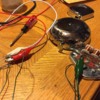What is striking the bell now? There's a lot of possibilities.
A rotory motor ( your stuck adding a coil type most likely) or linear motor (coil) etc etc?
A picture of what you have would be nice. Voltage? AC? DC?
Exactly what do.you wish to replicate?
You might be able to slow a rotary, but not get just one hit; that's harder. A stiff arm off the armature with both sides of the bell as stops along with polarity reversing is possible I suppose. ...Or a spring return I guess.
Coil and arm "rocker"?; is it one coil&spring-return, or two coils? Are they on a linear mount? Or coil(s) moving an arm?
Off hand, as an external striker for a 4" bell, maybe a momentary on toggle and a power door lock solenoid for a car, lol. But a little research on linear motors will get you something too. Pinball and coin op supply is a decent route to chase coil parts. Train accessory coils, if you had any, too.
Regulating a coil strike can be done with capacitors, and or relays, and or momentary switches. If a cap is used, you might need to say "how long is the minimum rest period between bell strikes going to be?". Relays might be used to ensure a "snap" action too. Old, two chime, ding dong doorbells usually have a dampening setting that can be applied to a chime mechanically. One bell being removed was another option.
Point is, it can likely be done; whatcha got in front of you now?
I used to relly like doorbells as a kid. Large houses might use AC and or DC + - to trigger door specific chimes on not just one chime set, but various. My aunts place had a control panel in the kitchen and hall so the bells could be turned on and off in the bedroom halls or servants quarters. Even our little 3 bed suburban bungalow had 1 chime ring for the back door and 2 for the front.












